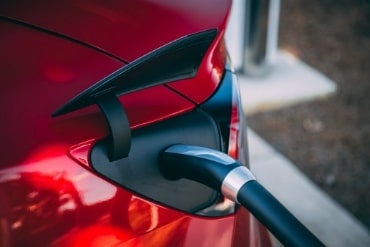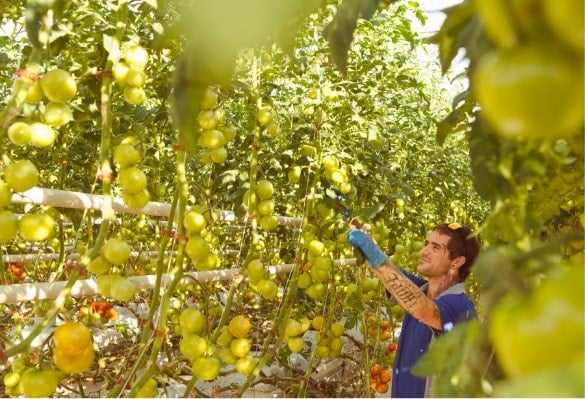Chapter 1
An introduction to sustainable technology
Consumers are beginning to make purchases with sustainability in mind. The modern shopper wants to know that the products they’re purchasing were manufactured with ethics at the forefront. There’s a growing demand for businesses to step up and show a sustainable initiative.
One of the leading industries for this green revolution is the technology sector. With tech playing such an integral role in the day-to-day life of most people, larger companies have had to do what they can to step up and embrace this new-found passion for sustainability.
Whether with a genuine desire to help the world, or just their bottom line in mind, a number of tech giants are doing what they can to make products greener. In this guide, we’re going to assess the current state of sustainable (or green) technology, while also looking at how larger businesses are doing their bit to help.
What is sustainable technology?
The phrase sustainable technology is something of an umbrella term. Technology that is sustainable operates through a trio of core principles:
Prevention.

Negative by-products of manufacturing are eliminated when green methods are utilised. That means things like contamination or anything that encourages deterioration. There’s also a focus on preventing any kind of potentially harmful environmental impact.
Substitution.

Perhaps at the core of sustainable tech use is the replacement of something which causes damage with a more environmentally friendly alternative. For example, a non-biodegradable substance being swapped out for something which will naturally break down over time, or a non-renewable resource being replaced with a renewable one.
Efficiency.

The technology has to be as efficient as possible in terms of its use of energy and any natural resources. That means no wasteful use of any of the central materials being used in a process.
Anything which has been produced keeping these factors in mind can be considered a form of sustainable or green technology.
The importance of green technology in sustainability
It’s clear that sustainable technology has a big impact on the world around us. But just how valuable is it in the overall fight for sustainability and natural resource management? Here are some of the most important ways technology has a positive impact on sustainability efforts:
Types of
sustainabe technology
To really understand the impact of this kind of tech, it’s important to get a grounding in the kinds of things which fall into the sustainable bracket. Some of the most prevalent forms of this kind of tech include:
Sustainable technology at home:
-
LEDS
While they might remind you more of something you’d find in decorative lighting, LEDs (light emitting diodes) are actually a fantastic way to illuminate a property without excess levels of energy consumption. These types of light use far less wattage than traditional options, making them a really desirable green alternative.
![Close up of LEDs]()
-
Solar powered homes
While the concept of using solar power from the sun has been prevalent for the majority of the 21st century, it’s only in the last few years that the renewable energy source has become seen as a viable alternative to traditional methods. The UK now produces a whopping 14 GW (gigawatts) of solar power per year, with hopes to expand this to 15 GW by the end of 2021. Homeowners can attach solar panels to their house in order to generate and store their own energy.
![Solar panels on roof of houses]()
-
Smart heating devices
In order to prevent excess wastage, smart meters can be placed in a home to cap your usage. They are also able to monitor where you’re using the most amount of energy, and help you adjust your habits accordingly. Devices can often be accessed via mobile apps, meaning you can stay on top of things remotely.
![Smart thermostat]()
-
Backyard wind turbines
The large scale turbines which can be found on wind farms aren’t the only way that power can be generated. There are also smaller versions which can be placed in the backyard to help power the home (or at the very least supplement energy usage).
![Small wind turbine]()
-
Dual flush toilets
By upgrading your toilet to one which uses a dual flush, you’ll waste less water every time you pull the chain. The flush works by letting you choose between a regular flush for liquid waste (which requires less water to remove), or a more industrial flush for solid matter.
![Bathroom with duel flush toilet]()
-
Electric transport
Another sustainable form of technology which was teased for years, electric vehicles (EVs) are now becoming increasingly common on British roads. The RAC estimates there to be as many as 300,000 EVs on UK roads, with a further 995,000 different kinds of hybrids (which use both electricity and a combustion engine). Government plans are for there to be an outright ban on the sale of new petrol or diesel cars by the year 2030.
![Electric car charging]()
-
Hydrogen power
This form of gas-based power is tentatively being considered one of the great saviours of the modern era. As something of an alternative for EVs, hydrogen-powered cars are able to store energy using less weight. This healthy battle between electric and hydrogen could help to accelerate both to new sustainable heights.
![Hybrid car]()
-
Wind-powered street lights
Wind power is a technology which has become increasingly popular in recent years. Roads could soon employ the use of street lights which produce energy as a result of the breeze. As most motorways are relatively exposed to the elements, there should be no shortage of supply.
![Wind street lights]()
-
Energy harvesting
Piezoelectric energy harvesting sees the natural heat and motion of cars running on the road converted into electricity. This is in turn used to power any electrical features of the road itself. The power is collected by a certain type of crystal, which can generate energy when pressure is applied to it.
![Moving car tyre]()
Sustainable technology stats and facts
Now we have a better understanding of what sustainable technology actually is, we can assess how much of an impact it has on the world around us. One of the best examples of how important the sustainable market is comes in the form of a report from the IEA.
They found that renewable forms of electricity will account for 196.1 GW of global power come the end of 2021. That was a steep rise from the amount produced in 2020, which totalled just 166.7 GW.
When broken down by region, China is without doubt at the forefront of electric energy production. The figures show rates to be:
78.4gw
China
31.9gw
Europe
24.4gw
USA
61.4gw
Rest of the world
Encouragingly, all forms of renewable power capacity saw a predicted net growth for 2021. In most instances, these saw a huge step-up from the figures shown the previous year:
14gw
Growth (from 2020)
13.6gw
Growth
17.3gw
Growth
9.7gw
Growth
Encouragingly, the UK Government is looking to embrace the development and use of green technology to fund next-generation forms of sustainable energy. As part of their plan to kick-off a new green industrial revolution, they are introducing the Net Zero Innovation Portfolio (NZIP).
This fund promises a total of £1bn across a number of priority areas, including the likes of:

Offshore wind

Energy storage and flexibility

Bioenergy

Hydrogen power

Disruptive technologies
As much as £92m of the total sum will be distributed to three core areas of green technology. Those being:
Energy storage
£68m
The bulk of the money will be directed towards enhancing the capabilities of energy storage technology. With the majority of renewable energy generated by the natural conditions of the weather (which can be unpredictable), it’s vital a constant supply of energy is kept stored year-round.
Bioenergy production
£4m
This form of energy is generated from organic materials, without the need to tap into any non-renewable sources such as fossil fuels. The money would be used towards cultivating low-cost and low-maintenance feed crops to be used for energy production.
Floating offshire turbines
£28m
With the UK fortunate enough to have a very expansive coastline, funding will also be diverted towards this form of natural energy production. Floating turbines can reach further out to sea than those embedded in the seafloor. This allows them to harness wind power which is much stronger, found in choppier waters.
Chapter 2
How tech giants are using sustainable technology
It’s the responsibility of bigger names in the tech industry to do what they can to promote the use and awareness of sustainable technology. Let’s look at what kinds of green tech are being implemented, as well as any efforts being made by larger corporations to make them a part of their day-to-day business operations.
What big companies are doing to be more sustainable
With so much weight placed on environmental issues by consumers across the world, it’s no surprise the tech giants of the world are doing what they can to embrace their demands. Here are some of the biggest changes which larger businesses are making in a commitment to be more green:
-
Google
![Google entrance]()
The global search engine giant that is Google has been at the forefront of sustainable technology for some time. In 2017, the company had managed to power itself with 100% renewable energy, a few years ahead of schedule.
And with A.I. (artificial intelligence) and global mapping systems which are far in advance of most other businesses, they’ve been able to turn attention towards searching for sustainable wins. Some big successes have come in optimising the use of solar energy, as well as regrowing and protecting forests.
-
Apple
![Apple store]()
Apple unquestionably holds dominion over the world of user-friendly smart technology, but what are they doing to ensure their impact on the world around them is a positive one? Well, it’s hard to really know. The company certainly makes something of a commitment to sustainability, but they lack the extra-curricular projects which Google can tout.
As part of their efforts to remain environmentally friendly, Apple claim to:
- Reduce waste in the manufacturing process
- Provide software which supports the control of energy-saving features on smart home appliances
- Select only environmentally friendly materials for manufacturing
- Provide recycling programmes for customers across the world
In truth, with what are relatively vague and somewhat unsubstantiated claims, it’s hard to really assess just how seriously Apple are taking their environmental impact.
-
Amazon
![Warehouse]()
Having come under some heavy fire for the amount of carbon their delivery vehicles were pumping into the atmosphere, Amazon founder Jeff Bezos was forced to act. In 2019, he announced the company’s commitment to following the Paris Accord – a legally binding treaty which laid out plans to operate more sustainably by those involved.
To take it one step further, Amazon would also co-found the Climate Pledge, which strives to meet the targets of the Paris Accord as much as ten years early. As of early 2021, over 100 signatures (including some big names like Heineken, Visa and Alaska Airlines) can be found on the Pledge. They would go on to announce four different levels of certification for Climate Pledge Friendly products, which would be sold on their online marketplace with discounts of anywhere from 15-25%.
What’s more, the company can also boast 206 renewable energy products across the globe, with 71 utility-scale wind and solar projects, and a further 135 solar rooftops.
-
Samsung
![Samsung building]()
This tech giant has been ahead of the curve for some time when it comes to sustainability efforts, having introduced the Samsung Environmental Declaration as far back as 1992. Their PlanetFirst initiative ensures that they approach every product with environmental impact in mind.
They use as few resources as possible in construction, while also reusing waste and end-of-life products. Just some of the steps they’re taking to ensure they reduce the size of their carbon footprint include:
- Using energy management systems at all work sites
- Monitoring and helping suppliers with greenhouse gas emissions
- Analysing the risk and impact of any proposed new product before manufacture
Every Samsung worksite operates by strict rules, meaning these practices are carried across countries and continents.
-
LG
![LG Phone]()
South Korean company LG acknowledges that while technological advancements are important, they shouldn’t be a priority over the health of the planet. That’s why they’ve introduced a zero negative environmental impact plan, which lays out a set of targets to strive for by 2030.
Those include:
- Reducing carbon emissions by 50% from 2017 to 2030
- Achieving carbon neutrality
- Achieving 95% in waste recycling at production sites
- Completing a switch to 100% electric vehicles or hydrogen business cars in South Korea
As well as this, they’re also looking to transition to 100% renewable energy across all areas of their business by 2050.
-
Sony
![Sony Headphones]()
Japanese firm Sony has introduced an environmental plan called “Road to Zero.” In truth, the targets for the plan aren’t entirely clear, but they intend to have reduced their environmental footprint by the year 2050.
While it’s something of a vague goal, they are at least taking steps to try and improve their sustainability efforts. Those include by:
- Introducing recycled plastics in manufacturing
- Reducing power consumption
- Eliminating plastics from the packaging of newer, small products
- Using more renewable energy
Even these changes are a little vague, so it will be interesting to see if the company comes out with further details about what they’re doing in the future.
-
Panasonic
![Panasonic Billboard]()
With an aim to ensure that energy usage is made as efficient as possible, Panasonic have introduced their Environment Vision for 2050. They were prompted to begin reassessing energy waste when they realised that just 10% of all energy they were creating was being put to good use.
Key areas of focus include:
- Reducing CO2 emissions
- Recycling as many resources as possible
- Limiting the use of water resources
- Lowering the impact of chemical substances
- Conserving biodiversity where possible
-
Microsoft
![Microsoft building]()
While most companies strive to become carbon neutral, Microsoft have set their sights a little higher. They are striving to become carbon negative by 2030 – meaning they not only offset the amount of carbon they put into the atmosphere, but actually reduce the amount.
A year into the project things appear to be going well. Some milestones the company have already hit include:
- A reduction in carbon emissions of 6% (roughly 730,000 metric tons)
- The purchase of 1.3 million metric tons of carbon removal from 26 projects across the world
- Providing total transparency by releasing their sustainability report to third-party companies (such as Deloitte), with sustainability progress serving as a determining factor in deciding executive pay
As if the pledge of carbon negativity wasn’t enough, Microsoft have also made it a goal to offset all of the carbon produced directly or through electricity which has been pumped into the atmosphere since their founding in 1973.
-
Dell
![Dell logo]()
Dell has implemented a project called Progress Made Real in order to hit their ambitious sustainability goals. These targets range from those which could be achieved in a few years, to more challenging endeavours. Some of their most important include:
- Reusing or recycling an equivalent product for everything they sell by 2030
- Using 100% recycled material in all packaging and over half of their production line by the same year
- Achieving net-zero carbon emissions by 2050
Keep what you’ve learnt in mind when considering which tech giants to opt for in the future. And remember, if you’re someone who likes to make ethically conscious purchasing choices, always do your own research first.
What businesses can do to be more sustainable
It’s not just the giants of the world who can do their bit to protect the world around them. Other businesses also have the potential to step up and make a real and meaningful impact. While they might not have the same resources available to them as the likes of Apple or Google, there’s still plenty that can be done to have a positive impact.
Some of the most effective ways to make a change include:
-
Remote working
A remote-first policy means your workforce are using considerably less carbon during their daily commute to work. This can have a huge impact on the overall carbon footprint of a business. What’s more, recent global events have highlighted how working from is a feasible option for a huge proportion of companies.
![Woman working at home]()
-
Energy-efficient upgrades
There are a host of energy-efficient upgrades any company can make to have a positive impact on their carbon footprint. They include things like LEDs, automated light sensors, smart thermostats and any other kind of smart sensory device. You can also make the switch to an energy supplier who offers a more sustainable approach. You’ll find that not only will the size of your footprint drop, but most likely also your monthly energy bills.
![Mobile app controlling lights]()
-
Green web-hosting services
While it might not seem like it, the internet, websites and even emails all use energy and even produce carbon. After all, something needs to power these digital marvels. Shop around and find a web-hosting service who have a proven commitment to remaining ethical.
![Hosting servers]()
-
Invest in carbon offsets
If you’re finding that the changes you’ve made aren’t doing enough to satisfy your need to be more sustainable, you can make direct investments by purchasing carbon offsets. This means paying a third-party a set amount of money to save emissions equivalent to those you’ve produced
![Forest]()
Schemes to promote sustainable technology
Fortunately for both larger and smaller companies looking to improve their environmental impact, a series of schemes exist to help support them. Here are just some of the initiatives which have been created to ensure sustainability is at the forefront in the digital sector:
Innovate UK’s Sustainable Innovation fund.
As part of their initiative for a green industrial revolution, the Government has made £134m available to more than 1,000 of the UK’s greenest businesses in order to help them thrive. A total of 1,069 businesses in total have been given £175,000 to further progress projects which look to heighten sustainability in the UK.
Some of the most exciting initiative who’ve benefited from this funding include:
A.I. used to help reduce beer waste
Robots that detect and repair cracks or potholes in roads
Seaweed conversion into compostable packaging
It’s hoped the money will provide these companies, which range in size, with a foothold to go out and make a significant difference.
Bio-energy Capital Grants scheme.
This initiative is aimed at championing the use of biomass for energy. Grants are awarded which can be used to fund the installation of equipment in biomass-fuelled projects in the commercial, industrial and community sectors. Some of the schemes primary aims are to:
Stimulate the UK renewable industry
Provide learning benefits that will accelerate the industry
Help contribute to UK targets for reducing greenhouse gas
Enhanced Capital Alliance scheme.
This scheme was created with the aim of encouraging businesses to invest in efficient technologies. You’ll be able to get total tax relief on certain investments, technologies and products for the first year, as long as they comply with the scheme’s interpretation of sustainability.
Cradle to Cradle Certified.
This global standard for the creation of products that are safe and sustainable is used as a stamp of authority for anyone looking to ensure they buy ethically. To be given a C2C certification, five different areas are assessed. Those being:
Material health
Product circularity
Clean air and climate protection
Water and soil stewardship
Social fairness
Once you’ve designated a product for certification, you can apply to one of the scheme’s many accredited assessment bodies for approval. You’ll work with an assessor to compile data, before being given a pass or fail mark for your efforts.
Chapter 3
The future of sustainable technology
Now we’ve taken a look at what companies are doing to fight for sustainability, let’s turn our attention towards the future. The way in which technology governs our lives is adapting and evolving on a daily basis. So it only stands to reason that our green tech will continue to change at the same rate. So what comes next for sustainable technology?
What a more sustainable future might look like
It’s impossible to know what the future has in store for us. But with something as data-driven as technology, you can at least make an educated guess. If the prioritisation of sustainable technology continues at the rate which you’d expect, here is a snapshot of what our society may one day look like:

Zero-carbon cities
With carbon continuing to stand out as the main antagonist of an environmentally-friendly future, it wouldn’t be unthinkable to see entire cities which have developed to the point of carbon non-dependency. With so many alternatives to carbon-based energy now available, it wouldn’t be out of the question to see cities outright ban its use.

Self-charging motorways.
The global push for EVs has and will continue to see a huge variety of electric cars on roads. If targets across the next few decades are met, we could see a near-exclusive electric motorway in the future. Should that happen, electric roads themselves may become the norm. These could take a number of forms.
There are already plans in place to use overhead wires to charge trucks, but this may not be a feasible option for regular vehicles. As such, we might see charging technologies employed in the road themselves. These would keep a vehicle topped up on electric power as they drive, reducing the need to stop and use manual charging points.

Sustainability at the forefront of politics.
Sustainability has already become a major talking point in a number of debates and even elections. But the growing pressure from voters to see global warming taken seriously could result in it overtaking the likes of taxation, international relations, education and even healthcare as the primary topic of debate.
A recent report found as many as 77% of voters across 11 European countries saw issues around climate change as one of the most important factors in deciding their vote. This was closely mirrored by young people (those aged 30 and less), where 75% chose based on this.
Sustainable technology currently being developed
We’ve already covered some of the incredible forms of green tech which have been introduced. But what’s currently in the pipeline? Here are some forms of sustainable technology which we might be seeing sooner rather than later:
Chapter 4
Useful Links
We’ve covered a lot in this guide, but there might still be more you want to learn about the world of sustainable technology. Make sure to check out these helpful secondary sources to discover more about the constantly evolving world of sustainable tech.



























